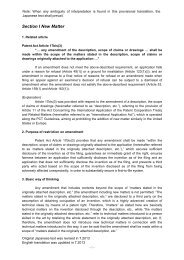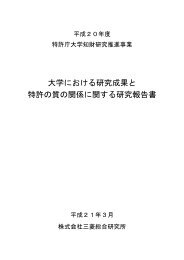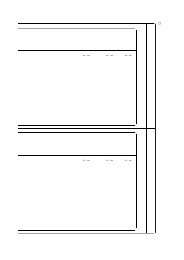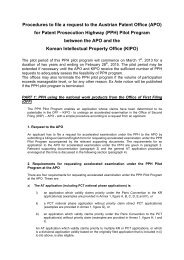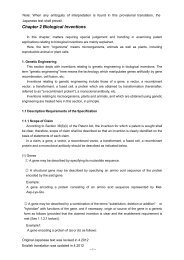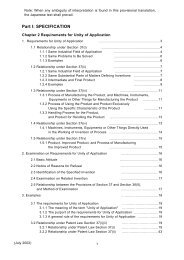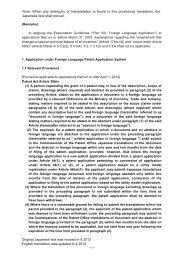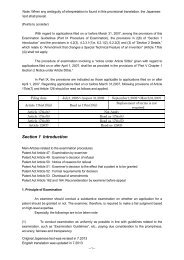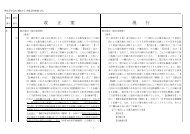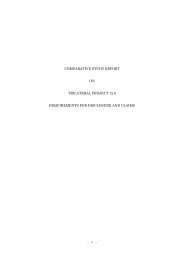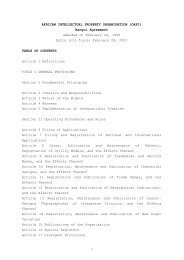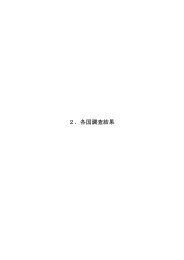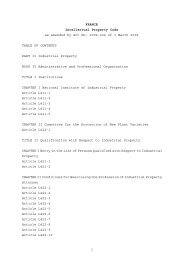Chapter 2 Novelty and Inventive Step - Japan Patent Office
Chapter 2 Novelty and Inventive Step - Japan Patent Office
Chapter 2 Novelty and Inventive Step - Japan Patent Office
Create successful ePaper yourself
Turn your PDF publications into a flip-book with our unique Google optimized e-Paper software.
Part II <strong>Chapter</strong> 2 <strong>Novelty</strong> <strong>and</strong> <strong>Inventive</strong> <strong>Step</strong><br />
Inventions subject to analysis of inventive step are novel "claimed inventions."<br />
2.4 Basic Idea of Analysis of <strong>Inventive</strong> <strong>Step</strong><br />
(1) The presence of an inventive step is determined based on whether or not it could be<br />
reasoned that person skilled in the art is able to easily arrive at the claimed inventions based on<br />
the cited inventions, by constantly considering the process the person skilled in the art may take<br />
based on the exact underst<strong>and</strong>ing of the technical field of the claimed invention as of the filing.<br />
(2) For details, after the claimed invention <strong>and</strong> one or more cited inventions have been<br />
identified, one of the cited inventions most suitable for the reasoning is selected, <strong>and</strong> the claimed<br />
invention <strong>and</strong> cited invention are compared to find the correspondences <strong>and</strong> differences between<br />
the matters used to specify the claimed invention <strong>and</strong> matters used to specify the cited invention.<br />
Then, reasons for denying the presence of an inventive step of the claimed invention are sought<br />
based on the details of this or other cited invention(s)(including well known <strong>and</strong> commonly used<br />
arts) <strong>and</strong> the common general knowledge. This reasoning may be conducted from various <strong>and</strong><br />
broad viewpoints. For example, it is examined to see if the claimed invention is selection of<br />
optimum materials, workshop modification, or mere aggregation or if the contents of the cited<br />
invention could be a cause or motivation of the claimed invention. In addition, an advantageous<br />
effect as a result of the comparison of the claimed invention to the cited invention is taken into<br />
consideration as grounds for positively presuming the presence of the inventive step when the<br />
effect is clearly described in the specification etc.<br />
As a result of this approach, the inventive step of the claimed invention is denied when<br />
the reasoning is valid <strong>and</strong> it is not denied when the reasoning is invalid.<br />
(3) In addition, the approach for identifying the claimed inventions <strong>and</strong> the cited inventions<br />
<strong>and</strong> that for comparing the claimed inventions <strong>and</strong> the cited inventions are also applied to the<br />
"Approach for determining the novelty." (See 1.5.1 – 1.5.4.)<br />
2.5 Examples of Reasoning<br />
Reasoning may be conducted from various <strong>and</strong> broad viewpoints. The following are<br />
examples of reasoning.<br />
(1) selection from optimum material, workshop modification, or mere aggregation<br />
I. selection from optimum material, workshop modification etc.<br />
The claimed inventions that are selection from optimum materials from publicly known<br />
materials optimally or preferably modified numerical ranges, materials replaced by equivalents, or<br />
designs modified along specific application of techniques to solve certain problems are regarded<br />
to be arts derived from the ordinary creativity of a person skilled in the art. When the difference<br />
from the cited inventions only lies in any one of these modifications, the claimed inventions are<br />
usually regarded as obvious to a person skilled in the art, unless other grounds for presuming the<br />
presence of the inventive step in the claimed inventions are provided.<br />
[Example 1] Sending or receiving signals using infrared waves of approximately 0.8 – 1.0<br />
μm of infrared energy wavelength range is recognized as a well-known art. Then, since there are<br />
17



